We’re diving into the world of plant royalty with the ever-so-popular philodendron pink princess plant that has captured my heart. This coveted plant boasts stunning heart-shaped leaves 💚💗 with a captivating blend of emerald green and bubblegum pink variegation. Let’s explore the care requirements and some tricks I’ve learned to boost that gorgeous pink coloration. 🌸✨
What is Pink Princess Plant
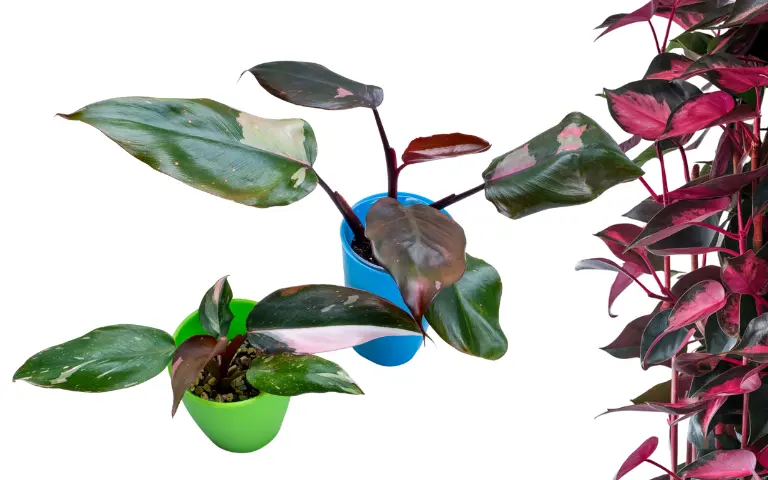
The pink princess plant is a type of philodendron. It is native to Colombia and has heart-shaped leaves that are green with pink stripes. It is a popular plant because of its unique appearance. This plant needs indirect light and a well-draining potting mix to prevent root rot.
This rare beauty thrives in a vertical environment, so providing a moss pole is highly recommended.
| Common Name: | Pink Princess Plant |
| Scientific Name: | Philodendron erubescens |
| Family: | Araceae |
| Plant Type: | Evergreen perennial, hybrid cultivar |
| Mature Height: | 24-48 inches (60-120 cm) |
| Growth Habit: | Climbing/vining |
| Fertilization: | Every 4-6 weeks |
The Mystery of the pink princess
The word on the street is that the pink princess plant is a mix of Philodendron erubescens and other philodendrons, but no one really knows for sure where the Pink Princess originally came from. The Pink Princess really looks a lot like its possible parent, erubescens. It seems pretty likely that the Pink Princess popped up as a little seedling in the greenhouses of Robert McColley in Florida. He was a big-time philodendron breeder who made tons of hybrids from the ’60s to the ’90s.
Growth characteristics
Is relatively easy to grow. However, its variegation slows its growth slightly due to reduced chlorophyll. Despite this, it remains a standard philodendron in terms of care.
Pink princess plant price
While finding a pink princess isn’t too difficult, securing one with striking variegation and strong genetics can be a challenge. This directly impacts the price, which can range from $50 to $300, fluctuating based on supply and demand, the quality of pink variegation, and the plant’s size.
My experience with the pink princess
My first pink princess plant journey started two years ago with a $50 purchase from a private seller on pinterest. The variegation was quite low, leading me on a quest to encourage more pink. exploring techniques like air layering, which yielded amazing results, including a fully pink leaf!
Prices are dropping and the pink princess is becoming more available. You can choose to invest in a high-variegated plant now or start with a lower-variegated one and encourage more pink.
Pink Princess Plant Benefits
Pink princess offers benefits for indoor plant enthusiasts:
- Its pink leaves make any space look good.
- This plant is easy to look after and likes indirect light, so it’s perfect for your indoor garden.
- It’s similar to the care recommendations for a philodendron pink congo.
- One of the key advantages of this philodendron is its impressive resistance to pests and diseases.
In extreme circumstances, mealybugs might pose a threat, but this is generally observed only when surrounded by heavily infested plants. This inherent hardiness makes the Pink Princess an exceptionally trouble-free indoor plant.
Pink Princess Plant Pets
Some pet owners worry that the pink princess plant is toxic to cats and dogs. It’s important to remember that some plants can harm pets if they eat them.
Is pink princess philodendron toxic to cats
The pink princess philodendron is toxic to cats. The symptoms can happen right away or take a few hours.
If a lot is eaten, it can cause more serious problems like kidney damage or failure.
If your cat ate this plant, call your vet. Treatment may include:
- Inducing vomiting.
- Giving activated charcoal.
- Providing supportive care.
Is pink princess philodendron toxic to dogs
The pink princess plant is toxic to dogs. It contains calcium oxalate crystals. Symptoms of ingestion.
- Irregular heartbeat.
- Difficulty breathing.
- Vomiting.
- Excessive drooling.
- Diarrhea.
If your dog ate a pink princess philodendron, call your vet. Treatment may involve:
- Fluids.
- Antihistamines.
- Stomach protectants.
- Observation until swelling goes down.
How to Care for a Pink Princess Plant
Rest assured, pink princesses are quite easy to care for and grow rapidly year-round. However, there are crucial aspects to keep in mind, especially for maximizing that stunning pink variegation.
Pink princess soil
Pink princesses thrive in well-draining soil mixes. I personally use a homemade airy mix for all my philodendrons.
For propagation, I’ve experimented with LECA (Lightweight Expanded Clay Aggregate), a semi-hydroponic substrate. A Pink Princess cutting transferred to LECA from water exploded with root growth and new leaves! If you’re rooting a pink princess cutting, I recommend starting in water, transitioning to LECA, and finally planting in a well-draining soil mix.
Light requirements
Indirect bright light encourages beautiful emerald green leaves. I’ve recently experimented with grow lights and observed darker leaves and more pronounced pink variegation. Insufficient light leads to a darker green color and potential reversion, diminishing that coveted pink.
Currently, all my Pink Princesses thrive under grow lights, proving to be the ideal condition for optimal variegation.
Watering
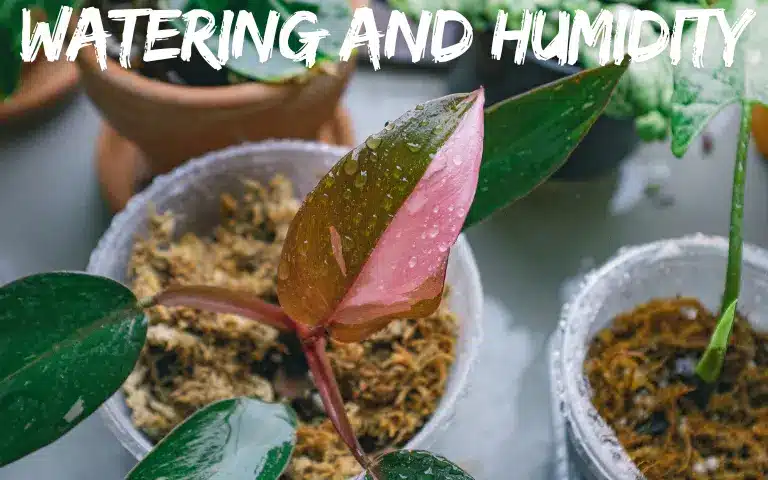
Watering techniques differ between soil and LECA. For soil-based plants, water when the top layer feels dry, avoiding soggy conditions that can cause root rot. For LECA, maintain a water level just below the roots to encourage healthy root development while preventing rot.
Humidity
Pink princess plant adore high humidity levels. Anything above 60% is ideal. Lower humidity, especially during new leaf unfurling, can cause the leaf to self-destruct and snap. Adequate humidity and moisture help the leaf unfurl smoothly, preventing damage.
I’ve unfortunately witnessed self-destruction firsthand due to insufficient humidity. At 40-50% humidity, which is typically acceptable for most Philodendrons, my Pink Princess snapped its new leaf during unfurling. Misting the new leaf generously with water and placing the plant near a humidifier has proven highly effective.
Temperature
Maintaining a temperature above 60 degrees Fahrenheit is essential for optimal growth, although the Pink Princess can tolerate brief dips below this threshold.
Pruning
You can control the growth of the pink princess by pruning it. Regular trimming can make the plant thicker. To prune effectively, identify the node, the point where the leaf joins the stem. Make your cut just above this node, ensuring you preserve the “eye” located on the backside of the stem. This discolored or dimpled area holds the potential for new growth.
Managing reversion
The captivating variegation of the pink princess is, unfortunately, unstable. This means the plant can revert to being fully pink, which, while visually striking, is unsustainable due to the lack of chlorophyll, or completely green.
If this happens, locate the most variegated leaf on the plant and make a cut just above its node, again ensuring you leave the “eye” intact. In most cases, this will encourage the plant to revert to its variegated form.
Repotting
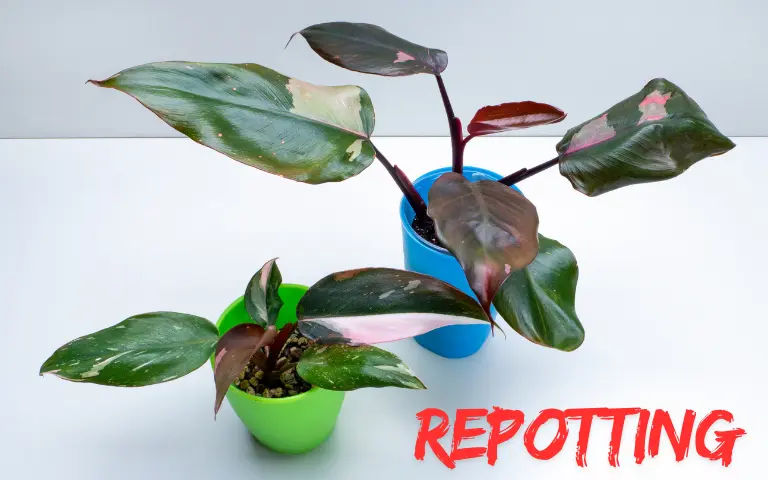
When repotting becomes necessary, carefully remove the plant from its existing pot. Healthy roots will be abundant and tipped with white, fuzzy growth. Transfer the plant to a larger container, centering it and filling the space with fresh potting mix. Firm the soil gently and leave a small gap, known as “freeboard,” at the top to accommodate watering.
Remember to thoroughly soak the soil after repotting, allowing excess water to drain, ensuring the entire root system is hydrated.
Climbing
To encourage climbing, provide a support structure like a moss pole or trellis. Your pink princess plant will thank you! This will help it grow and climb in a beautiful, graceful way, adding a touch of elegance to any indoor space.
Stem Color and Reversion
Stem color is a telltale sign of a pink princess’s genetic potential. Plants with minimal stem coloration often produce green leaves. In contrast, those with pink variegation extending along the stems and petioles are more likely to exhibit strong variegation in their leaves.
If you notice your plant reverting, cut it back to the point where you last observed variegation. However, keep in mind that maturity plays a significant role. Young, immature plants are more prone to reversion, while those with developed heart-shaped leaves are more likely to showcase their pink potential.
Propagating a Pink Princess Philodendron
Something was wrong with one of my plants pink princess philodendron. Looking at her, you can tell she’s not doing well. Her leaves are starting to turn in places, and the base of the stem is showing signs of rot. This is why her leaves are falling, and it’s time for a drastic solution: propagation!
I’m going to propagate her in a few different ways, so let’s get started!
Preparing for propagation: chopping
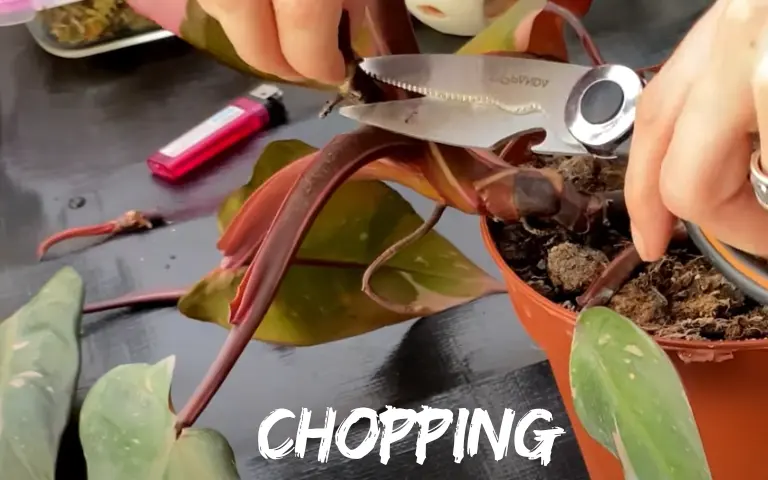
- The first thing you need to do is light a candle. It’s not just for mood lighting; you’ll be using it to seal the ends of the stems once we’ve cut them, but you can also use a wax melt warmer or a hot frying pan.
- Before you start chopping, make sure your tools are clean. Dirty tools can make your cuttings rot and stop them growing.
If you look at the plant stem, you’ll see little bumps called nodes. These are super important because they’re where the roots will grow. No nodes, no roots!
- Cut just below the nodes, leaving about 3-4 centimeters or maybe millimeters, to make sure that bit has nodes.
This is a bit risky, since the more foliage a cutting has, the more energy it needs to support, making it more likely to fail. But if you have the option to take smaller cuttings, I strongly recommend it. They have a much better chance of rooting and becoming full plants.
- Wait a few minutes for the sap to stop oozing, and then seal the ends of the stems with wax. You can also sear the ends with a hot frying pan, but I’ve always used wax.
Why do we seal the ends? If you don’t, they can rot during propagation, causing the cutting to fail. That’s it for the chopping! Now, we’ll focus on propagation.
Propagating in water: simple and effective
One method of propagating a pink princess plant is to root the cuttings in water:
- Use rooting hormone on the nodes. It helps roots grow and keeps them moist.
- It is important to use clean water and change it regularly to prevent the growth of bacteria or algae.
- Put the cutting in water and keep it in a bright, indirect light. Make sure it’s not too cold.
It should hopefully start to develop roots in a week or two. Once they’re a couple of inches long, plant them in soil.
Propagating in sphagnum moss
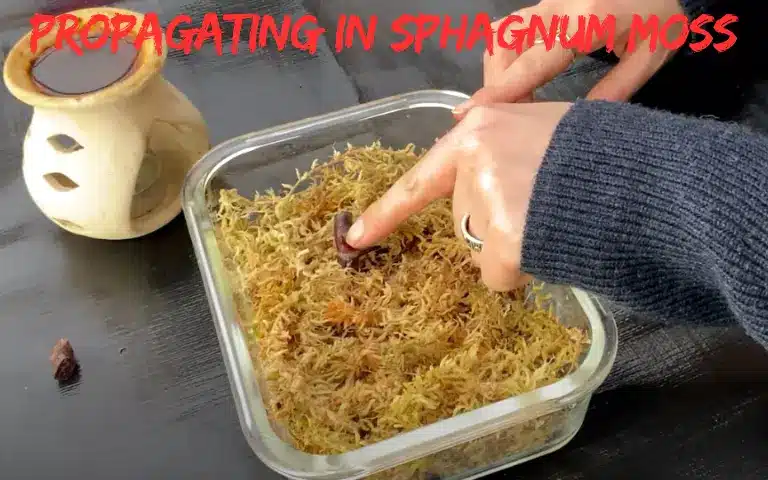
Another method of propagating a pink princess plant is to use sphagnum moss as a propagation medium. Remember that tiny growth point on the cutting? It looks like a tiny eye! You need to make sure that the growth point is pointing up so that your new plant can grow.
- Place the cutting into the moss, ensuring that the nodes are covered, but the growth point is exposed.
- Close the box to create a humid microclimate to encourage root growth.
- Keep an eye on your propagation boxes regularly since the warm, humid environment can encourage rotting.
Now it’s a waiting game. It’s crucial to wait until the roots are a few inches long before planting your cuttings. If you plant them too soon, they can go into shock, and you might have to start the propagation process again.
Common Problems With Pink Princess Plant
Why isn’t my pink plant showing much pink?
- Ensure the plant receives enough bright, indirect light to promote variegation.
- Younger plants might not show as much variegation as mature plants.
- Some plants naturally have more or less pink.
Why are my pink princess plant leaves turning brown?
- Try increasing the humidity in its environment.
- Keep an eye out for spider mites or aphids.
- Move the plant to a spot with indirect light.
Pink princess plant wilting
A wilting pink princess doesn’t always mean the end. It can be caused by different things. Here are some common causes and solutions:
- Make sure your plant isn’t sitting in water and the soil is well-draining. Water when the soil is dry.
- If the soil is dry, your plant may wilt. Check the soil moisture often.
- Too much or too little sunlight can cause your plant to wilt or grow weak.
- Your plant prefers temperatures between 65 and 80°F (18 and 27°C). Extreme temperatures can hurt plants.
Pink princess plant leaves curling 😨
Leaves curling on a pink princess mean something’s wrong.
- Dry air makes leaves curl inwards to conserve moisture. Check the soil and water if it’s dry.
- If your princess’s roots are in a small pot, they can’t absorb water well, so they curl. Repot into a larger pot with fresh soil.
Pink princess plant leaves turning yellow
Sometimes its leaves may turn yellow. Don’t panic, here are some possible reasons and solutions:
- The plant needs more nutrients. Feed your plant with fertilizer during the growing season.
- Sap-sucking insects can make your plant weak, causing yellowing.
- If you think the plant is sick, put it in a separate place and get advice.
Pink princess plant bleeding 😱
If your pink princess philodendron is bleeding, it’s experiencing “guttation.” This bleeding is natural, especially at night when the plant isn’t actively photosynthesizing. The pink sap is a defense against insects.
Guttation happens when the plant takes up more water than it needs. The water is forced out through tiny pores on the leaves, carrying minerals and sugars.
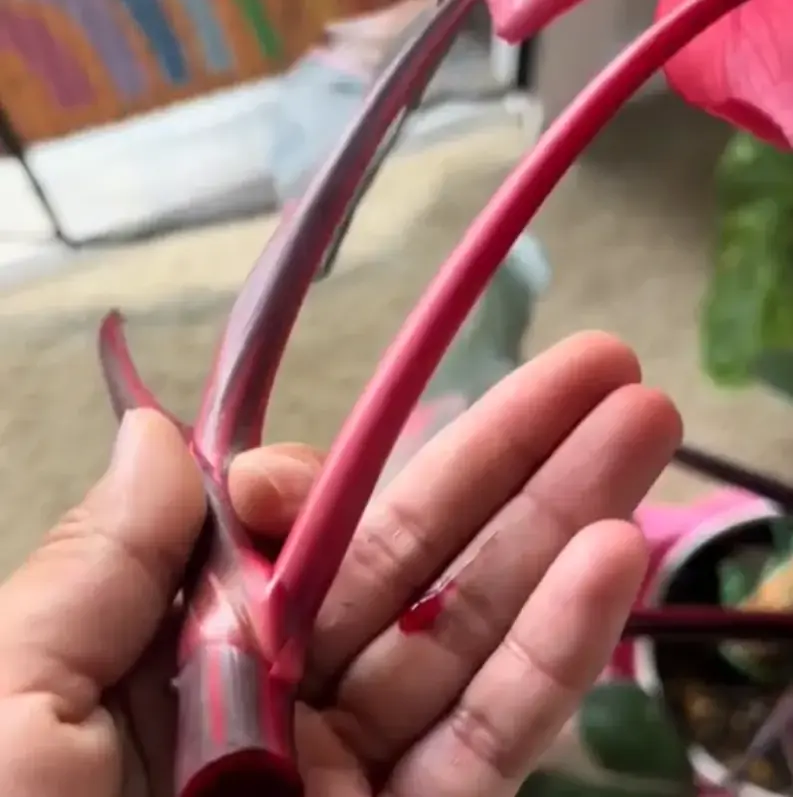
Can I grow my pink princess plant outdoors
It can be grown in USDA hardiness zones 10-11, where temperatures do not fall below 50°F (10°C). Put it in a shady spot with some light and humidity.
This concludes my pink princess plant care guide and personal experiences. I hope these insights empower you to successfully cultivate your own vibrant Pink Princess! Don’t forget to share your thoughts and experiences in the comments below. Happy growing!
Frequently Asked Questions
How often should I fertilize my Pink Princess Plant?
Fertilize your plant every 4-6 weeks (spring and summer) with a balanced, water-soluble fertilizer diluted to half strength. Stop fertilizing in the fall and winter.
What type of pot should I use for my Pink Princess Plant?
A terracotta or plastic pot with good drainage and the right size for the plant’s roots is fine.
How do I make my pink plant more humid?
Use a humidifier.
Put the plant in a tray with water and pebbles.
Mist the leaves regularly.

About the Author
As a woman expert in sustainable, environmental, and natural farming methods.
I write about houseplant care sharing tips and tricks i’ve learned over the years to help keep your plants happy and healthy.



